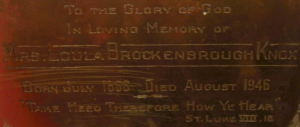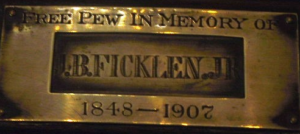In this final installment of this series we will look at a couple of “pew controversies” and the memorials that are attached to a number of the pews.
All was not harmonious in the pews. Pews were objects to be bought and were taxed. It was inevitable that controversies arose.
In early January, 1908, Brodie Herndon, the personal representative of Miss Parker Herndon, brought to the Vestry’s attention Pew 63. He wanted to place a memorial there and use the pew for “visiting strangers” and would $100 was provided to be invested at 5% a year to pay the pew tax. It was referred to the Finance Committee. The committee was concerned about obtaining that yield and did not want to be held responsible for making the investment and possibly recommending a poor investment. (Assuming a bond would be used for investment, the S&P high grade bond yield was 3.40% for that year). They came back to the Vestry in April 1908. The Vestry decided to return the $100. Instead a plate would be put in the pew as memorial to her parents and the pew was deeded to the Church. The plate is still there today.
Another controversy involved pew 88. In March, 1897 two members of the Vestry (A. W. Wallace and D. S. Forbes) were appointed to look into an ownership question about pew 88. Apparently it was claimed by Hoomes Johnson and William Slaughter. No mention of the committee’s work took place until April, 1898. Apparently Johnson had written the Vestry about donating the pew to the Church under “certain conditions” but “there had been some misunderstanding.” D. S. Forbes and Robert Knox were appointed to look into this issue.
In Edgar Young’s pew book (which began in March, 1899) it is written – “by the order of the Vestry this pew was turned over to Mrs. W. L. Slaughter” and then it is marked “Easter, 1908.” It was occupied by 1916 by Mrs. H. M. Eckenrode. Apparently all taxes were cancelled on the pew since on April 18, 1924 it was given to the Church.
This series concludes with a list of memorials and plaques in the pews which are referenced by number:
40, 41,54,55 – IMO Loula Brockenbrough Knox – July 1866 – August, 1946
It is appropriate Ms. Knox had four pews with her name plate. She endured the loss of her husband, Douglas Knox in 1917 and then her two sons, Douglas, Jr. and Thomas Fitzhugh the next year. Douglas Jr. died on June 15, 1918 of four wounds suffered as a private sharpshooter in the 6th marines. He was one of the first from Fredericksburg to fall in that war. Mrs. Knox was from Richmond County, Va. and had moved to Fredericksburg when she married Douglas Knox in 1887. He was a grocer at 405 Commerce (William) Street.
A service flag was dedicated in 1918 with fifty blue stars and one gold star. There was also an engraved roll of honor framed with all the names who died in the war.

48 – W. F. Ficklen
Brother of John B. Ficklen and partner in Bridgewater Mills business. The mill sat on the lower raceway, just south of the Falmouth Bridge in Fredericksburg. It had the capacity of producing about 160 barrels of flour (10 grades) and 400 bushels of meal per day in the late 19th century. In 1884, about 110 horsepower of water power was required to run the mill.
60- Epiphany, 1926 – Rector’s pew presented IMO Virginia S. F. Boyseau Doggett
Ms Doggett was the wife of Dr. A. C. Doggett and came to Fredericksburg in 1870 and when she died in 1906 was 70 years old. She had one daughter Kate Doggett who presented the pew and for the rector’s family and also a credence table and $500 towards the purchase of an organ. Mrs. Doggett was described in her obituary as a “Christian worker of the highest type.”
64 – IMO E. F. Fitzhugh Chichester 1874-1974 who occupied this pew
IMO Alice Chichester Hundley 1911-1998 who occupied this pew
Mrs. Chichester was a Sunday school teacher and president of Female Charity School which helped to educate needy children. With Mrs. W. W. Butzner, Sr, she organized the first Parents Teacher Organization (PTA) in Fredericksburg. Her daughter, Alice Chichester Hundley, lived in Grand Haven, Michigan with her husband who was dean of Grand Valley State College in Allendale, Michigan
65 – James Parke Corbin. Corbin was born in 1847 at Moss Neck and died in 1904. He graduated from VMI and W&L and was one of the cadets at New Market. He moved to Fredericksburg in 1894 and lived at the corner of Lewis and Charles Streets. He was then elected twice as Clerk of the Courts, the second time unopposed. He was also an insurance agent and became manager of the Daily Star newspaper.
63 – Miss Parker Herndon. In memory of parents B. L. Herndon, Mary Gordon Herndon
Miss Herndon was only 37 when she died of a fever and served as a Sunday school teacher at St. George’s
51 – J. B. Ficklen 1848-1907
City Council member, President of Rappahannock Electric Light and Power and managed Bridgewater Mills. Trustee of St. Georges. Rappahannock Electric provided electricity for city street lights as well as power for homes, businesses, industry, and public buildings. On November 3, 1887, Fredericksburg was lighted for the first time with electricity.

43 – Hoomes Johnston
Johnston, born in 1861 died in his 46th year in 1907 of congestion in his lungs and was a druggist. He started in his father’s drug business (Fayette W. Johnston) but bought his own store in 1883 and then merged with George Pearson’s drug store in 1886. He bought out Pearson’s interest in 1904. He married Carrie Ficklen in 1897, a daughter of J. B. Ficklen. The pallbearers in 1907 was literally a “who’s who” in Fredericksburg at the time.
19.- Mrs. A. T. Harrison
According to historian Quenzel Mrs. Annie T. Harrison of Philadelphia (1868-1939) was a “a generous friend of St. George’s on numerous occasions and presented the congregation with “a very beautiful and costly antique lecturn.”
13 – R. R. Hall (Robert Rush Hall)
A pharmacist. His grandfather established one of oldest drug firms, J B Hall Sons. He was a brother to Marshall C. Hall, who superintendent of the Sunday School here for over 30 years.
10 – Dr. Carmichael
W. Carmichael (Spottswood) died in his 76th year and was the son of Dr. George Carmichael. He graduated at 18th from the University of Philadelphia and was a surgeon in the Confederate Army of Northern Virginia and was in charge of a hospital. He practiced with his father first where the Daily Star writes he “showed his fitness.” He married Fanny T. Bryan and one of his sons, R. B. Carmichael also entered the medical field.
93 – R. M. Doswell
Richard M. Doswell was an Aide-de-Camp to C.S.A. General Seth Barton; Lived in Norfolk remaining years
87 – Chichester
There is no first name but it is probably RHL (Richard Henry Lee) Chichester who lived between 1870 and 1930, lawyer and judge. He did not complete a UVA legal education due to illness but like earlier lawyers read the law and acquired a license to practice in Fairfax County at the age of 22. He served two terms as Stafford’s Commonwealth Attorney and then in 1898 was elected by the General Assembly to serve on the county courts of Stafford and King George. After that district was eliminated he practiced law until appointed to the circuit court bench of Stafford, King George, Spotsylvania, Caroline and Hanover. He was charged with political corruption in 1915 but was absolved of all charges. In 1924, he was appointed one of five judges of a new court created, Special Court of Appeals. At his death he was also president of the Free Lance –Star Publishing Co. which published the local paper.
